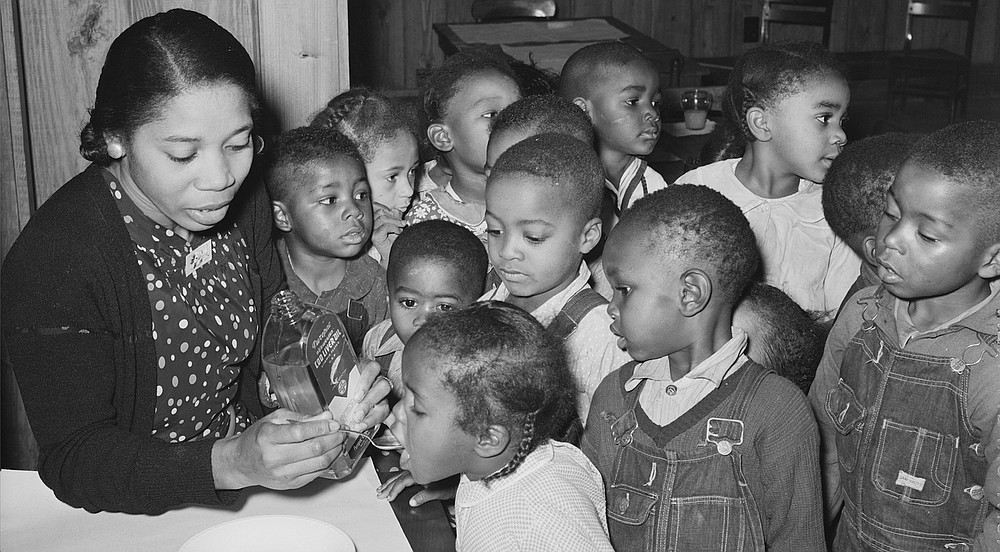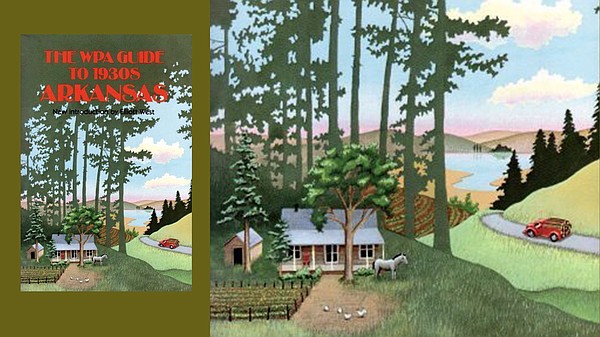[ad_1]
In 1941, Arkansas operated eight state parks. Seven have been open solely to white guests. The eighth was put aside for the second-class residents politely referred to as Negroes.
Peaches have been a significant money crop in Arkansas again then. At now vanished Highland Peach Orchard, south of Murfreesboro, practically 1,000,000 Elberta peach bushes reached so far as the attention might see.
Fox searching nonetheless passed off in rural Arkansas eight a long time in the past, however with out the English custom of driving to hounds. Native hunters most popular to calm down open air with a smoke and a drink whereas listening for the distinctive bark of every canine pursuing the fox.
Toby reveals toured the state’s rural areas earlier than World Struggle II. The barker, often known as “Toby,” would hawk sweet containers touted to comprise tickets for profitable a plaster elephant or another gewgaw. Then he and a few supporting gamers would move the hat as they entertained the group with homespun comedy.
And in Little Rock because the Nice Despair ended, a dozen homeless households lived in shacks of scrap lumber and tar paper on a riverfront patch often known as Squatters’ Island. Considered as a vacationer attraction, they grew tomatoes, okra, peppers and pumpkins within the alluvial soil.
These time-warp nuggets and numerous extra are scattered among the many lodes of knowledge, a lot of it fascinating and a few even wonderful, within the 448 pages of “The WPA Information to Arkansas.”
The ebook, created for the New Deal’s Works Progress Administration by a platoon of federally paid writers and editors, was printed in 1941. It was among the many final of 48 state guides revealed, beginning in 1937, by the company’s a lot debated Federal Writers’ Venture. The collection additionally included the Alaska Territory, Puerto Rico and Washington, D.C.
Reprinted in 1987 with a contemporary introduction as “The WPA Information to Nineteen Thirties Arkansas,” the unique quantity wafts right now’s readers again to what was then the primarily rural “Surprise State” however quickly to get a brand new nickname: “Land of Alternative.”
At present, Bentonville has 54,164 residents and the 2020 Census estimated 546,725 residents within the Fayetteville-Springdale-Rogers metro space. Bentonville’s inhabitants within the 1940 U.S. Census was 2,359. Springdale’s was 3,319. Rogers’ was 3,550. Fayetteville’s was 8,212. The mixed rely of 17,430 in 1940 was handily surpassed by the 21,290 for Pine Bluff — then the state’s fourth largest metropolis, now right down to No. 10.
The information’s 1987 version may be purchased on-line for $25 to $40 or learn without spending a dime at some libraries (there are different reprints as nicely, together with one by Trinity College Press in 2013). The 1941 authentic sells in some venues for lots of of {dollars}. The contents painting Arkansas at a fracture level between the Nice Despair and U.S. entry into World Struggle II. Numerous sights, usually routine again then however vanished or altered now, flash by on the information’s eight metropolis excursions and 17 driving routes (generally on unpaved state highways).
POTPOURRI OF TOPICS
Previous the in depth touring sections are 19 essays on a potpourri of matters that make clear private and non-private life eight a long time again. Among the many topics are Pure Settings, Archaeology and Indians, Historical past, Transportation, Agriculture, Recreation, Faith, Folklore and Folkways, Authorities, and Music.
Answerable for the information when the venture started in 1938 have been notable Arkansas literary figures Bernie Babcock and Charles J. Finger. They have been quickly changed by Dallas McKown, who completed the process beneath the sponsorship of then-Secretary of State C.G. “Crip” Corridor. The checklist of consultants talked about 147 contributors.
“To acquire info for the information, employees of the Arkansas Writers’ Venture have haunted libraries, dealt with numerous light paperwork in archives, and have learn lots of of books, magazines and newspapers,” McKown wrote. “They’ve pushed 1000’s of miles over highways that crisscross the Delta, slice by deep pine forests, comply with river valleys, and experience the ridges of the Ozarks and Ouachitas.”
The Federal Writers’ Venture drew persistent criticism nationally from conservative quarters, notably the Home Un-American Actions Committee. Fees by the committee targeted on alleged Communist connections or sentiments that have been by no means substantiated. The accusations included the supposed selling of racial integration, at a time when Jim Crow legal guidelines dominated the South and racial discrimination was widespread elsewhere.
“The WPA Information to Arkansas” comprises no evident sympathy for any easing of authorized segregation — a lot much less ending Jim Crow legal guidelines. Separate public amenities are talked about as a matter of pure course, as with “Watkins State Park (for Negroes), 8.9 m. NW of Pine Bluff on U.S. 270.” The park is not on the map.
STEREOTYPES in 1941
Black communities are lined on the eight metropolis excursions and elsewhere within the information. However city Black persons are usually depicted in stereotypical phrases as happy-go-lucky types trying primarily for a very good time. Feedback about rural Black individuals may be much more offensive, specializing in ignorance and superstitions. Studying them in 2021 would offend many readers of any pores and skin shade.
The information additionally echoes some stereotypes about backwoods white Arkansans, as in these descriptions from a route by Newton County south of Jasper:
“The ladies put on sunbonnets, and plenty of of them use snuff, taking a small amount on the tip of a ‘tough elm toothbrush,’ and chewing it like plug tobacco. Hill individuals contemplate dipping snuff, or placing it on the decrease lip, an unclean behavior, match just for white trash and lowlanders.
“The lads are weather-beaten and have tiny wrinkles about their eyes. Their loose-kneed, shambling gait is ungraceful, however deceptively quick, whether or not they strike out for city six or eight miles away, or are simply making a circle to kill just a few squirrels.”
MULE POWER
Arkansas agriculture was changing into extra mechanized as World Struggle II loomed, progress mirrored on this tribute to the mule:
“Although their quantity has declined since tractors took over a lot of the extent land, mules are nonetheless most popular to horses in cotton fields. The mule is hard, cussed and wiry. He drinks water so muddy {that a} self-respecting horse would snort at it. He humps his again to a wintry wind and nibbles forage a mustang would scorn.”
On Saturdays, farmers and their households would head to the closest city. Important Streets have been the facilities of purchasing, nicely earlier than the arrival of purchasing malls on arteries resulting in interstates and different highways. That is what it was like in Blytheville:
“Important Avenue is a large sunny avenue lined with brick shops and places of work. Buyers are most quite a few on Saturdays. On today, the shops placed on further clerks, barbecue and hamburger stands put together for a rush, and the motion-picture theaters invoice Western thrillers.
“Farm individuals pack the sidewalks to promote produce, purchase groceries and drygoods, and meet their mates. Sacks of feed and coops of squawking chickens are piled excessive exterior the shops on the jap finish of Important Avenue. Maybe an enormous catfish, fresh-hooked from a Mississippi slough, dangles earlier than a lunchroom.”
Scorching Springs was additionally vigorous because it welcomed vacationers, however with leisure actions principally totally different from right now:
“Out of doors {photograph} studios, the place guests have their footage taken astride a slumbering burro or behind a prop saloon bar, spring up in vacant tons subsequent to luxurious motels. Small retailers serve contemporary seafood, fruit juices or goat’s milk. Stands show crystals, curios, souvenirs and trinkets. Within the slender canyons, patrons of capturing galleries blaze away into the mountainside.”
The information’s 1987 reprint added a brand new introduction by Elliott West, a College of Arkansas, Fayetteville historian. He asserted that “if there’s a widespread theme uniting the previous and the current and the state’s numerous components, it’s that of poverty.”
That’s much less true in 2021 within the state’s metropolitan areas, however it stays a lamentable truth of life in lots of small cities and rural areas. Per-capita earnings in Arkansas right now ranks forty fifth among the many 50 states.
RHAPSODIES
However the opening pages of the unique version cite Arkansas’ non-monetary treasures. These different avenues of delight are described in rhapsodic phrases, which curmudgeonly readers may view as saccharine:
“A part of the wealth of Arkansas right now will not be in its minerals and forests, however within the sights and sounds encountered by a customer.
“It could be the small thunder of a covey of quail that he’ll bear in mind longest, or a flight of mallards wheeling down right into a swamp due to a hunter’s expertly rendered name, or the intense glow of straw stacks burning within the rice fields after threshing time. The zigzag rail fences overgrown with honeysuckle, the clear smokeless air within the cities, the tumbling of the mountains eastward from Winslow, the scent of wooden smoke from an awesome stone chimney on the finish of a cabin, the pungency of pine sawdust and the whine of the noticed biting right into a log, the clumps of mistletoe in leafless bushes.
“You will not neglect these items quickly, although they don’t seem to be the essential elements of Arkansas, the place the politeness of the South and the friendliness of the West are each liable for the non-public tone in ‘Y’axe hurry again.'”

It was time for cod liver oil within the nursery college when Farm Safety Administration photographer Russell Werner Lee (1903-1986) visited the Lakeview Resettlement Venture, 15 miles southwest of Helena, in December 1938.
(Library of Congress Prints & Images Division)
[ad_2]
Source link


Recent Comments